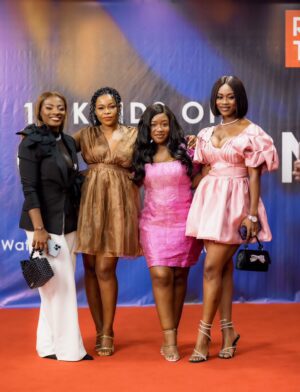
In the heart of the bustling city of Lagos, Nigeria, lived a young woman named Aisha. Aisha was known for her vibrant smile and unyielding optimism. Despite her cheerful demeanor, she had been caught in a turbulent cycle of bad relationships. Her friends often wondered why she continued to choose partners who only brought heartache and frustration.
One day, Aisha confided in her best friend, Chinedu, a thoughtful and perceptive man who had always been a steady presence in her life. As they sipped their tea in a small, sunlit café, Aisha expressed her deep frustration. “Why do I keep finding myself in these unhealthy relationships?” she lamented. “I always end up heartbroken.”
Chinedu, who had witnessed Aisha’s painful pattern, decided to share a story of a man he knew, hoping it might shed light on her situation.
**The Story of Kofi and Esi**
In the serene village of Asante, Ghana, there lived a young man named Kofi. Kofi was a skilled carpenter, renowned for his intricate woodwork. Despite his professional success, Kofi’s personal life was marred by a series of problematic relationships.
Years ago, Kofi had met Esi, a charming and ambitious woman from a neighboring village. Esi was captivating, with her fiery spirit and eloquent speeches about dreams and aspirations. Their initial encounters were full of promise, filled with laughter and shared dreams. However, as time passed, Kofi noticed a shift in Esi’s demeanor.
Esi’s ambitions began to overshadow their relationship. She often criticized Kofi’s work and belittled his efforts, believing that his focus should be on supporting her dreams rather than his own. Despite the growing tension, Kofi felt trapped in a cycle of trying to please Esi, fearing that if he spoke up, he would lose her.
Their relationship continued to deteriorate. Esi’s constant demands and Kofi’s inability to assert himself led to endless arguments. Eventually, Esi left, leaving Kofi disheartened and confused. He wondered what he had done wrong and why he seemed to attract such tumultuous relationships.
**Patterns of Bad Romance**
As Chinedu recounted Kofi’s story, he pointed out that the patterns Kofi experienced were not unique. Many people, like Aisha, found themselves in repetitive cycles of unhealthy relationships. Chinedu explained that understanding these patterns could offer valuable insights into breaking free from them.
He highlighted a few common patterns:
1. **Unresolved Past Issues**: Often, individuals bring unresolved emotional issues from their past into their relationships. Kofi’s unresolved self-worth issues and Esi’s previous insecurities created a volatile mix that led to their downfall.
2. **Choosing Partners for the Wrong Reasons**: Many people, including Aisha, choose partners based on superficial traits or a desire to escape loneliness. This can result in being drawn to partners who may not be a good match emotionally or intellectually.
3. **Lack of Communication**: Effective communication is crucial in any relationship. Kofi’s inability to communicate his feelings and boundaries led to misunderstandings and resentment.
4. **Fear of Being Alone**: Fear of loneliness can push individuals into relationships that are not beneficial. Aisha, despite her better judgment, stayed in relationships that were clearly unhealthy because she was afraid of being alone.
**Aisha’s Reflection**
Listening to Kofi’s story, Aisha began to reflect on her own experiences. She realized that she had often chosen partners who seemed exciting and different but who ultimately did not align with her values or needs. Her fear of being alone had led her to overlook red flags and stay in relationships that caused her pain.
Determined to break free from this cycle, Aisha decided to take some important steps. She began by focusing on her own self-worth and addressing her unresolved emotional issues. She also sought counseling to understand the patterns that had led her into unfulfilling relationships.
Additionally, Aisha worked on improving her communication skills, learning to express her needs and boundaries clearly. She understood that being alone was not something to fear but an opportunity for self-growth and reflection. By addressing her fear of loneliness and prioritizing her emotional well-being, Aisha hoped to make healthier choices in the future.
**A New Beginning**
Months passed, and Aisha’s efforts began to pay off. She felt more confident and content with herself. Her newfound self-awareness and improved communication skills enabled her to navigate relationships in a healthier way.
One day, while attending a community event in Lagos, Aisha met a kind and understanding man named Idris. Idris was different from her previous partners; he was respectful, empathetic, and shared similar values. As their relationship developed, Aisha noticed the stark contrast between this and her past relationships.
Idris supported Aisha’s dreams and valued open, honest communication. He encouraged her to pursue her passions and respected her boundaries. With Idris, Aisha found a sense of partnership and mutual respect that had been missing in her previous relationships.
**Conclusion**
Through her journey, Aisha learned valuable lessons about breaking the cycle of bad romance. Understanding and addressing the patterns that had led her to unfulfilling relationships allowed her to make more informed choices. Kofi’s story and Chinedu’s insights had provided the clarity she needed to recognize and change these patterns.
As Aisha and Idris built their relationship, she felt a renewed sense of hope and optimism. She knew that while the cycle of bad romance could be challenging to break, it was possible with self-awareness, communication, and a willingness to learn and grow. And so, in the vibrant city of Lagos, Aisha embraced a new chapter in her life, filled with promise and the lessons she had learned along the way.








